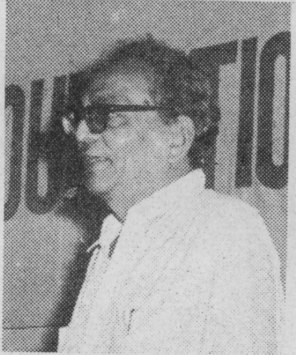
Srirangam Srinivasa Rao, popularly known as Sri Sri, was an Indian poet and lyricist who is known for his works in Telugu literature and films. Noted for his anthology Maha Prasthanam, Sri Sri is a recipient of a National Film Award, a Nandi Award and a Sahitya Akademi Award.
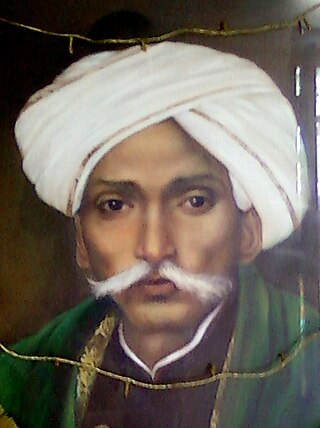
Gurajada Venkata Apparao was an Indian playwright, dramatist, poet, and writer known for his works in Telugu theatre. Rao wrote the play Kanyasulkam in 1892, which is considered as the greatest play in the Telugu language. One of the pioneers of Indian theatre, Rao holds the titles Kavisekhara and Abyudaya Kavitha Pithamahudu. In 1910, Rao scripted the widely known Telugu patriotic song "Desamunu Preminchumanna".

Sir Chettur Sankaran NairCIE was an Indian lawyer and statesman who served as the Advocate-General of Madras from 1906 to 1908, on the High Court of Madras as a puisne justice from 1908 to 1915, and as India-wide Education minister as a member of the Viceroy's Executive Council from 1915 until 1919. He was elected president of the 1897 Indian National Congress, and led the Egmore faction, opposing the Mylapore group.

Dwaram Venkataswamy Naidu was one of the most important carnatic music violinists of the 20th century. Naidu was partially blind. He received the Sangeet Natak Akademi Award in Fine Arts in 1953. Government of India conferred on him the Padma Shri Award in 1957. Several members of his family are also notable Carnatic violinists.
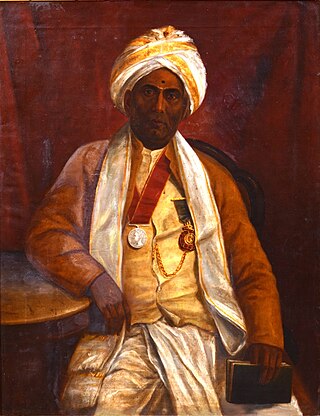
Sir Thiruvarur Muthuswamy Iyer was an Indian lawyer who, in 1877, became the first native Indian during the British Raj to be appointed as justice of the High Court of Madras, acting as Chief Justice in 1893.
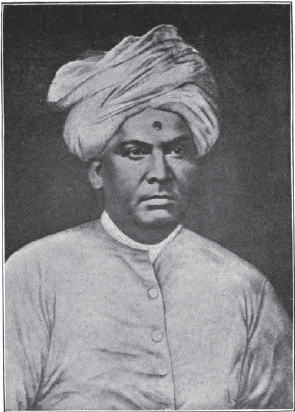
The Right Hon. Calamur ViravalliRunganada Sastri was an Indian interpreter, jurist, civil servant, polyglot, and social reformer, who was known for his mastery over Indian and foreign languages alike in both classical and vernacular forms, as well as his general erudition and command of jurisprudence. At his death, he is known to have mastered fourteen languages, and had a conversational command of at least two to four more.

Diwan BahadurSir Calamur Viravalli Kumaraswami SastriKt. was an Indian jurist, statesman, and Sanskrit scholar who was leader of the Madras Bar as a Vakil of the High Court, before being appointed as a puisne justice of the Madras High Court in 1914, and, later, Chief Justice of the Madras High Court. He also served on numerous special committees; most notoriously, the Rowlatt Committee - service on which nearly imperiled his later service as Chief Justice. The great-grandson, great-great-grandson, and great-great-great-grandson of celebrated Sanskritists, he himself was noted for achieving "brilliant success, with speed" from his first days practicing law. In his heyday, he was considered "the most brilliant representative of the Madras Judicial Service", and the successor to V. Bhashyam Aiyangar.
Sastri is a surname. Notable people with the surname include:

Chetput Ramaswami Iyer Pattabhiraman was an Indian lawyer and politician from the Indian National Congress. He was the eldest son of Indian statesman C. P. Ramaswami Iyer. He served as a Member of Indian Parliament from Kumbakonam from 1957 to 1967 and as a Union Minister from 1966 to 1967.
Dewan BahadurCalamur Viravalli Viswanatha Sastri was an Indian jurist and statesman who served as a justice of the High Court of the Madras Presidency, following and alongside his elder brother Dewan Bahadur Sir C. V. Kumaraswami Sastri. He was awarded the Kaisar-i-Hind Medal in 1934.

The Mylapore clique or oligarchy was a small coterie, amounting to a "handful" of politically moderate, elite Brahmins, many of them noted lawyers, administrators, academics or educators, or industrialists, in the Madras Presidency, who 'wielded almost exclusive influence and patronage in the service and government appointments', 'controlled the flow of resources out of the institutions of the capital' and 'dominated the professional and political life of [the presidency].' Informal and exclusive, it was historically controlled by two extended families, the Vembaukum Iyengars, and the Calamur Viravalli-Chetpet Iyers, and took its name from the luxurious Madras City neighborhood in which many leading members kept mansions. The clique coalesced and began its dominance in the 1880s and 1890s under the headship of Sir V. Bhashyam Aiyangar and Sir S. Subramania Iyer, with R. Raghunatha Rao as a tertiary leader; while some argue that it reached its zenith between 1910 and 1920, others highlight its remarkable successes in ministry and magistracy continuing in the 1920s and 1930s, with Sir C. P. Ramaswami Iyer as leader.

The Vembaukum or Vembakkam family were one of the two preeminent Brahmin dynasties in the Madras Presidency, dominating the Mylapore clique alongside the Calamur clan, and 'possess(ing) an enormous presence in the... bureaucracy of the capital and its surrounding district(s)', whose historical presence began in the 1820s, with the sprawling clan famously having begun holding yearly family conferences by the 1890s to preserve their dynastic unity, political cohesion and influence, and wealth.
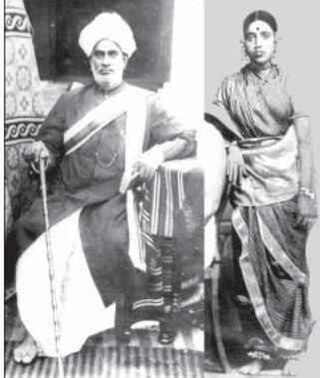
Chetpet Ramaswamy Pattabhirama Iyer, surname alternately spelt Aiyar, originally surnamed Dikshitar, was an Indian lawyer and jurist, noted for having led the Tanjore Bar and served as the Tanjore public prosecutor, before relocating to the city of Madras, whereupon he ultimately became a Vakil of the High Court of Madras, central member of the Mylapore clique, and a leader of the Madras bar, along with M. O. Parthasarathy Iyengar, V. Krishnaswamy Iyer, P. R. Sundaram Iyer, Sir V. C. Desikachariar, and Sir C. Sankaran Nair, immediately behind Sir V. Bhashyam Aiyangar and Sir S. Subramania Iyer, from 1891.
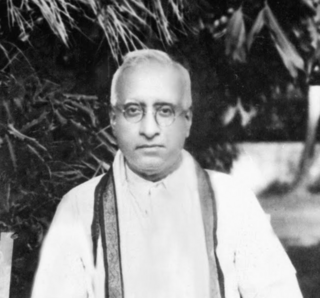
Diwan Bahadur RayaVallur Nott Viswanatha Rao was an Indian civil servant and statesman who served as Finance Secretary, Law Secretary, and Education Secretary of the Madras Presidency, as well as in the Legislative Council of Madras, and as Collector of Tinnevelly, and of Tanjore.

Calamur Viravalli Sundara Sastri was a leading Vakil of the High Court of Madras, second in the Calamur line to bear the style Viravalli, and of a family line occupying a prominent position and status within the Madras Presidency; a "giant" of Madras jurisprudence, with a "very large" practice on the Original Side, which he shared with his partner and adoptive brother, Sir P. Ananda Charlu. Sundara Sastri published a Revised Set of the Rules of Practice for Original side litigation, which became de rigueur, and was noted as an orator with 'perfect' diction. He authored the Sundararāmāyaṇa.
Calamur MahadevanFNAFGMMSI, sometimes known as C. Mahadevan, was an Indian specialist in economic geology, marine geology, and nuclear geology, and 1934 Founding Fellow of the Indian Academy of Sciences, elected for Earth and Planetary Sciences, serving on the Council of the Indian Academy of Sciences from 1948 until his 1962 death. Chosen as a Fulbright scholar, with aid from the United States National Research Council, he taught at the Massachusetts Institute of Technology. Appointed to the first Professorship of Geology at Andhra University after fourteen years as Superintendent Geologist at the Geological Survey of Hyderabad, he was known as a doyen or foundational figure in the field of Indian geology.

The Calamur Viravalli family, inclusive of closely intermarried "merged" lines was one of the two preeminent Brahmin dynasties in the Madras Presidency who dominated the Mylapore clique, alongside the Vembaukum family. They were originally Vadama Iyers from Kalambur and nearby hamlets in North Arcot, who traced their ancestry to Appayya Dikshita, and before that, Deshastha movements from the North. They were traditionally by hereditary profession renowned Sanskritists, as with Anantharama, father of patriarch C. V. Runganada Sastri, Anantharama's father, and Anantharama's father's father, but rapidly adapted to the practice and administration of law and English-style governance, with many Calamurs coming to rank among India's most celebrated lawyers, jurists, administrators, and statesmen.
Vembakkam Comanduru Gopalratnam, son of Sir V. C. Desikachariar, grandson of V. Rajagopalacharlu, grandnephew of V. Sadagopacharlu, brother-in-law of K. Bhashyam Iyengar, and son-in-law of V. V. Srinivasa Iyengar, was himself a top-ranking lawyer, writer, humorist, and legal historian, whose magnum opus was The High Court , finished just months before his death in 1962. He was also author of Hāsya Nāṭakaṅkaḷ Kaṭṭuraikaḷ, a work in Tamil. A member of the Vembaukum family, he co-edited the quarterly trade journal The Lawyer and was partially resident in Vasantavilas, where he took on as a junior a youthful Randor Guy.
Calamur Chandrasekhara SastriB.A. FMU (1854–1887), sometimes Sastry or Sastriyar, was the first Principal and Professor of English and Sanskrit of the Maharajah's College at Vizianagaram from his appointment in 1875, developing it from a secondary school with four teachers into a graduate institution before his death at the age of 32 in 1887, with the support of the contemporaneously reigning Maharajas of Vizianagaram, Pusapati Vijayarama Gajapathi Raju III and Pusapati Ananda Gajapati Raju. He was the first Indian principal of any South Indian college at the time.











